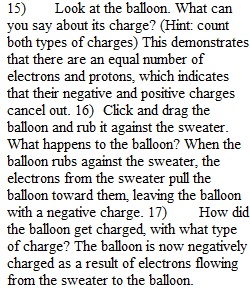


Q Exploring electric charges PURPOSE: USE SIMULATIONS TO EXPLORE ELECTROSTATIC INTERACTIONS In this online lab you will use simulations to check your knowledge regarding electrostatic interactions. Balloons and Static Electricity Simulation To interactively explore some of the concepts you have learned so far please go to the Physics Education Technology Web site (https://phet.colorado.edu/en/simulation/balloons-and-static-electricity). We will start with the Balloons and Static Electricity simulation, found under Physics -> Electricity, Magnets and Circuits. If the link above does not work, try https://phet.colorado.edu/sims/html/balloons-and-static-electricity/latest/balloons-and-static-electricity_en.html Once your application has started, click “Reset Balloon”. Make sure that only the “show all charges” and “wall” buttons are selected. 1) Look at the balloon. What can you say about its charge? (Hint: count both types of charges) 2) Click and drag the balloon and rub it against the sweater. What happens to the balloon? 3) How did the balloon get charged, with what type of charge? 4) Where did that charge come from? 5) What happened to the sweater? How did it get charged? 6) Bring the balloon in the middle, between the sweater and the wall. What happens to the balloon when you let it go? Explain. 7) What is the overall charge of the wall? 8) What do you think will happen when the balloon is brought close to the wall? Predict first. 9) Bring the balloon in contact with the wall. What happens to the charges in the wall? 10) Let go of the balloon. What happens? Explain. 11) Click the “Reset Balloon” button. Select “show all charges”, and “Two balloons”. What can you tell about the overall charge of all the objects in your simulation window? 12) Select “Show charge differences”. Rub each balloon against the sweater. What happens to each one of them? 13) Why are the two balloons stuck on the sweater? 14) Try to get one balloon off the sweater by using the other balloon. Can you do it? If yes, explain why this is possible. ? Now open the John Travoltage Labat https://phet.colorado.edu/en/simulation/john-travoltage or https://phet.colorado.edu/sims/html/john-travoltage/latest/john-travoltage_en.html 1) Predict what will happen to John if he rubs his foot against the carpet. 2) Rub John’s foot on the carpet by clicking and dragging his foot few times. What happens? 3) Predict what will happen if John touches the door knob. 4) Click and drag John’s hand such that it touched the doorknob. What happened? 5) What would you call what happened to John? 6) How is this different from the balloon and sweater or balloon and wall touching each other?
View Related Questions